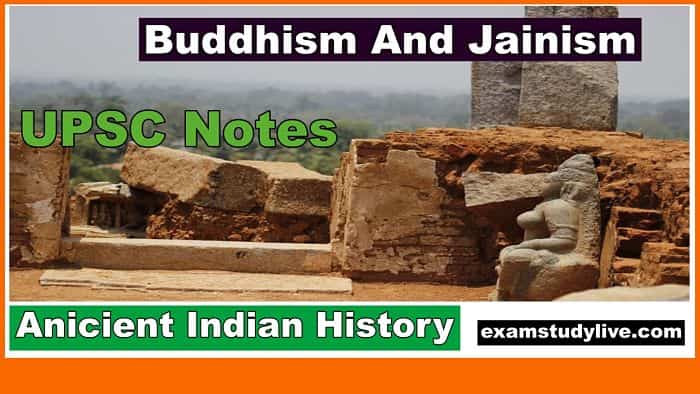In this article you get Buddhism And Jainism Notes For UPSC
Buddhism And Jainism
It was founded by Gautam Buddha. His original name was Sidharth & nickname Gaura. He is known as Sakyamuni \& Tathagatha. He was the 9th incarnation of god. He is also named as the ‘Light of Asia’.(Buddhism And Jainism Notes For UPSC)
He was born in 563 B.C. at Lumbini garden near Kapilvastu in Nepal on the day of Vaishakha Purnima, in the Sakya Kshatriya clan.

His father Suddhodhana was a Saka Ruler and his mother Mahamaya was a Princes of the Kasola Dynasty.
His mother has died after seven days of his birth. Then he brought up his stepmother Mahaprajapati Goutami.
At the age of 29, he left home when he saw an old man, sick person, dead body, and ascetic.
His chariot was channa and horse – Kanthaka
His first teacher was Alara Kalama with whom he started meditation and the next teacher was Udraka Ramaputra.
At the age of 35 after 6 years of meditation on the riverbank of Niranjana under a Pipal tree, he got Nirvana.
He gave his first sermon at Sarnath and his last sermon at Vaishali.
(Buddhism And Jainism Notes For UPSC)
At the age of 80, he got Parinirvana at Kushinagar in 483 B.C. He gave four noble truths.
- The world is full of the sorrow or suffering
- Suffering is caused by desire
- Desire can be controlled or stopped
- It can be controlled by an eightfold path which is popularly known as Astangikamarga
I. Right Action
II. Right Concentration – meditation
III. Right Conduct
JV. Right Effort
V. Right Faith
VI. Right Livelihood
VII. Right Speech
VIII. Right Thought
He is called Light of Asia.
He is called Light of Asia. He had many disciples but the top ten disciples were :
- Sariputta
- Moggallana – Top master of supernatural powers
- Mahakassapa – Top master of ascetic training – the first man who preached the Buddha’s teaching directly
- Upali
- Rahul
- Ananda
Prajapati Gautami was the first woman disciple of Buddha.
There were six Buddhist councils held till date but four are important.
- The first Buddhist council held in 483 B.C. under Ajatasatru at Rajagriha. The chairman was Mahakasappa. In this council, Vinaya Pitaka and Sutta Pitaka complied.
- The second Buddhist Council held in 383 B. C. under Kalasoka at Vaishali. The chairman was Sabakami.
- The third Buddhist council held in 250 B. C and Ashoka at Pataliputra. The chairman was moggaliputta Tissa. In this council, Abhidhamma Pitaka has complied.
- The fourth Buddhist council held at Kundalavana. The king was Kanishka. The chairman of the fourth Buddhist council was Vasumitra. In this Buddhist council, the Ruddhicm divided into Mahajana and Hinayana.
Also read this: What is Prehistory – Paleolithic, Neolithic & Mesolithic Age Notes
(Buddhism And Jainism Notes For UPSC)
During the 8th century, the third type of Buddhist group called Vajrayana appeared in Bihar and Bengal Thow thought salvation can be attained through magical power. So they freely consumed meat fish wing etc.
Buddhism stands three pillars
1. Buddha – Founder
II. Dhamma – Teaching
III. Sangha – The Order of Buddhist nuns and monks.
In the Pali language, Buddhist literature is written. They are mainly under a three-fold basket called Trinitakar
1. Vinaya Pitaka-Rules
II. Sutta Patika-Sermon
III. Abhidharaa Patika-Philosophy
Mahavamsa and Deepvamsa are other Buddhist texts. They provide information about Sri Lanka
The biography of Buddha is known as Buddha Charit written by Ashwapasha book.
Lumbini, Bodhgaya, Sarnath, and Kushinagar are four important places where involved.
The other places related to Buddhism are-Amaravati of Andhra Pradesh Nalanda- Bihar, Junagarh and Vallabhi in Gujarat. Sachi-M. P Ajanta and Ellora in Maharastra Dhauligiri, Jaugarh, Ratnagiri-Odisha Kaunoj, Kaushambhi, Mathura-UP.
Patrons of Buddhism – Bimbisara, Ajatasatru, Prasanjit, Udayana, Pradyota, Ashoka, Milindo, Kanska, Harshavarshan, Gopal, Dharmapada, Rampala, Gautama Buddha.
Also Read this: VEDIC AGE – Early & Later with Social, Political, Economic, Cultural Life Notes
(Buddhism And Jainism Notes For UPSC)
JAINISM
According to Jain tradition, there were 24 Tirthankara. The first Tirthankara was Rishavadeva or Adinatha and 24 Trithankara was V. Mahavira.
Jainism was founded by Rishavadeva with the emblem bull. Parshavnath and Mahavira has historical importance parshavnath was the 23rd Tirthankara with emblem snake He gave four doctrines:-
- Ahimsa – Non-Injury
- Satya – Non-Lying
- Astaya – Non-Stealing
- Aparigrahi – Non-Possession
Mahavira was the 24th Tirthankara with emblem lion. He added five doctrines was which included four of parshavnath –
- Satya,
- Ahimsa,
- Asteya,
- Aprarigraha,
V.Brahmacharya (celibacy)
Mahavira was born to Sidhartha and Trishala during the 6th century B. C. at Kundagrama near Vaishali in Bihar.
At his early age, he married Yoshada and blessed with a baby girl called Priyadarshini.
At the age of 30, he left home and become ascetic. He meditated with Gosala maskriputra but Gosal maskriputra left him and who later founded Alivikas Sect. After 12 years of meditation, he attained Kaivalya at Jrimbikargama under a Sal tree.
on the riverbank of Rijupalika. He gave his first sermon at Rajgir to his 11 disciples.
Then he was called Jaina or Jitendriya and his followers known as Jains. At the age of 72, he attained the death at Pavapuri.
The literature of Jainism was written in Ardha Magadhi language. For this enlargement of Jainism two Jain councils held at Pataliputra and Vallabhi.
First Jain council held in 300 B. C. under the Patrm of Chandragupta Maurya. During this council 12, Anga started complied. Second Jain council held Vallabhai under Devardhi – final compilation of Anga.
Jainism divided into two types.
- Swetambara-Sthulabhandra
- Digambara-Bhadrabahu
Patron of Jainism
- Chandragupta Maurya
- Kharavela
- Amoghavarsha
Architecture of Jains
- Hatigumpha and Baghagumpha at Udayagiri and Khandagiri.
- Shravamabelagola statue of Gomateswar Bahubali – Karnataka
- Dilwara temple – Mount Abu – Rajasthan
- Girnar-Gujarat
(Buddhism And Jainism Notes For UPSC)
